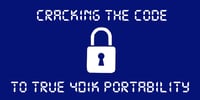 America’s 401(k) system, long plagued by friction, produces $92.4 billion of excessive cash-out leakage annually. In recent years and culminating in 2021, the private sector has finally “cracked the code” and is delivering innovative fintech solutions, combined with education and personal assistance to reduce friction and to enable true 401(k) portability.
America’s 401(k) system, long plagued by friction, produces $92.4 billion of excessive cash-out leakage annually. In recent years and culminating in 2021, the private sector has finally “cracked the code” and is delivering innovative fintech solutions, combined with education and personal assistance to reduce friction and to enable true 401(k) portability.
Supported by extensive research and empirical analysis, these solutions are transforming retirement savings portability and will increasingly deliver significant, measurable benefits to plans, participants, financial advisors and to the entire 401(k) system.
Solving the Problem of Friction
The problem of ‘friction’ in our 401(k) system is real. Anyone – including industry professionals – who has attempted to perform a do-it-yourself (DIY) roll-in knows this all too well. While a plan-to-plan consolidation following a job change can often be a participant’s best choice, unfortunately the easiest choice is simply to cash out, or to leave a small, unconsolidated balance behind.
Now, in 2021 there are two primary solutions available to plan sponsors that deliver true 401(k) portability:
- Auto portability, which the DOL bestowed its guidance upon in 2018 and 2019, automatically moves small balances of less than $5,000 forward. Auto portability was embraced by Alight Solutions in 2020, and in 2021, they are beginning to offer the solution to their plan sponsor clients. With more recordkeepers set to adopt auto portability, the feature could soon reach critical mass – where the traditional automatic rollover paradigm is completely replaced.
- Meanwhile, a facilitated roll-in program can apply to all participants, all balances and works by isolating participants from roll-in complexity by pairing workflow technology with expert assistance. Although the facilitated roll-in now represents the market’s best practice, as auto portability takes hold, the full automation of all 401(k) plan-to-plan roll-ins may not be far behind, as they begin to leverage auto portability’s infrastructure, data security, data exchange and operating standards.
In combination, these solutions are making 401(k) portability the “easy choice” for job-changing plan participants and are turning the friction dynamic on its head:
- Financial wellness can be significantly and measurably boosted by preserving retirement wealth and reducing cash-out leakage.
- Society benefits when retirement savings are preserved – but particularly minorities, lower-income workers and women.
- Participants are better positioned for retirement income through the consolidation of stranded balances, and they can reduce their cost of retirement by eliminating redundant account fees.
- Plan metrics are improved through the reduction of stranded accounts and uncashed checks, and fiduciary risk is lowered by minimizing lost and missing participants.
- Existing and future retirement-savings public policy initiatives that promote increased retirement savings can more quickly and easily achieve their goals.
Research vs. Real-World Proof Points
Time and again, research from the Employee Benefit Research Institute (EBRI) has projected that widespread adoption of auto portability will generate large systemic benefits. In one study, EBRI estimated that, for accounts below $5,000, adoption of auto portability would deliver an incremental $1.5 trillion in retirement savings. Extending portability to all balances, would provide another $0.5 trillion, for a total increase of $2.0 trillion.
But what about the real world?
Now, there’s undeniable, empirical evidence revealing just how incredibly effective an actual program of 401(k) retirement savings portability is in boosting participants’ financial wellness.
A March 2021 study, Assessing the Ongoing Impact of a Program of Retirement Savings Portability, was released by Retirement Clearinghouse (RCH) and follows on to an April 2013 study by Boston Research Group. It examines the experience of a mega plan sponsor (250,000+ participants) with a program of 401(k) retirement savings portability, from 2013-2020. The study finds that 50% cashout reductions have not only been maintained, they’ve improved, while account consolidations have soared. Most importantly, the study quantifies the benefits of portability, finding that the program “significantly & measurably impacted the financial wellness of the plan’s participants” – preserving retirement savings of at least $1.12 billion, while saving participants an estimated $79.4 million in fees.
The Portability Code is Cracked
The private sector, including financial technology innovators and leading recordkeepers, has finally cracked the code to true 401(k) retirement savings portability. Now, leading 401(k) plan sponsors and the private sector corporations they represent are moving quickly to implement portability programs as a primary vehicle to improve their participants’ financial wellness and to foster broad, societal benefits.
